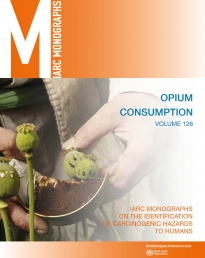
978-92-832-0165-6
978-92-832-0193-9
View The Lancet Oncology summary as HTML or PDF
French version of The Lancet Oncology summary (hosted by Centre Léon Bérard)
Read Q&A
View infographic
This volume of the IARC Monographs provides an evaluation of the carcinogenicity of opium consumption.
Opium is a highly addictive narcotic drug that has been used for centuries for medicinal and non-medicinal purposes. It has analgesic, hypnotic, antitussive, gastrointestinal, and cognitive effects.
Produced from the juice (latex) of the unripe seedpod of the poppy plant (Papaver somniferum), opium has a complex chemical composition consisting of at least 25 alkaloids (e.g. morphine, codeine, thebaine) and other substances. There are several forms of opium (raw or crude opium, dross, refined opium, or opium sap), all of which can be smoked or ingested. Opium derivatives such as morphine, codeine, and heroin were not considered in the present monograph.
Although opium production and distribution are controlled internationally, opium is produced illicitly in some 50 countries worldwide, with more than 80% coming from Afghanistan. The world’s largest per capita consumers of raw or minimally processed opium are the Islamic Republic of Iran, Afghanistan, and Pakistan. In 2018, there were an estimated 5 million users of illicit opium worldwide.
After reviewing epidemiological evidence, animal bioassays, and mechanistic data to assess the carcinogenic hazard to humans of opium consumption, the IARC Monographs Working Group concluded that opium consumption is carcinogenic to humans (Group 1).
Annex 1. Supplementary material for Section 1, Exposure characterization
The supplementary web-only tables were produced in draft form by the Working Group and were subsequently fact-checked but not edited. Please report any errors to imo@iarc.fr.
Table S1.6.2E Exposure assessment quality of mechanistic studies on opium exposure
Annex 2. Methodological considerations for epidemiological studies on opium consumption and cancer